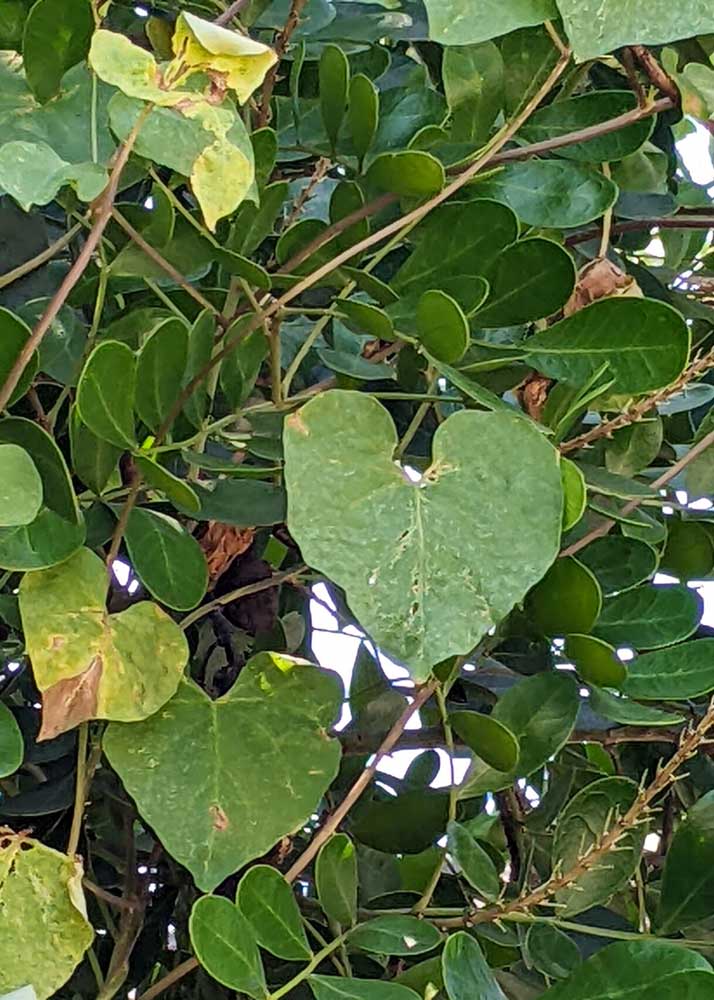Sperry: Get to the root of the issue with morning glory invasion
Published 5:10 am Sunday, September 8, 2024

- Morning glory can be stubborn. (Contributed Photo)
Dear Neil: I have this vine (see photo) climbing up my Texas mountain laurel. An app suggests that it’s a morning glory. How can I eliminate it? It’s at the base of the mountain laurel that has otherwise been surrounded by lantana for several years.
Your app served you well. There are some tenacious members of the morning glory clan, many of them perennials that keep coming back vigorously from their roots every spring. Your best bet would be to dig down with a large trowel or sharpshooter spade and separate the plant from its root system. Let the top die before you try to remove it from the mountain laurel. Its stems will become dry and brittle. At that point they’ll be much easier to break and pull out. Weedkillers aren’t going to be of much help because the roots are extensive, and you’d have a hard time getting enough of the herbicide into the plant’s leaves to kill the entire vine.
Dear Neil: My house is less than two years old. I have had trouble getting grass to grow. The house faces north, and I only have about 11 feet between my house and my neighbor’s (zero lot line). I have hybrid bermuda, but I don’t think I have enough sunlight. The builder also brought in clay soil before planting the grass. The ground gets packed down due to traffic, and I can’t aerate due to rocks. Can I build up the soil base by adding better soil each year?
Goodness. Where do I start? First of all, while you still have summertime sun, take measure of how many hours of direct sunlight this area receives from late spring through summer and into early fall. Those are the prime growing months. Bermudas need 7 or 8 hours of direct sunlight. Zoysias need 6 or 7. St. Augustine needs 6 hours. That’s to thrive in each case. You might be able to shave one hour off each estimate if an area had no traffic and if your measurements were really accurate.
Adding soil will not help. Lack of light is lack of light and it’s totally unrelated to soil and nutrition. As for the traffic, no grass is going to be happy in shade with a lot of traffic. Bermudas hold up better, but we’ve already ruled it out due to insufficient light. St. Augustine might survive, but it doesn’t hold up to traffic. If you have a lot of people walking through you might go for steppingstones or a gravel pathway with edging and then use a groundcover such as purple wintercreeper euonymus. It would cost a bit more to get started, but the frustration factor would be so much reduced. I’ve used a lot of it in my landscape.
Dear Neil: Can you recommend a weedkiller for our vegetable garden? Is there anything organic that works? We’re reluctant to use Roundup near our vegetables.
Some people use horticultural vinegar to burn weeds back, but I’ve never wanted to recommend it because it does not do a good job of actually killing the weeds – it just sets them back a few paces. Roll-type mulches work well in that they block the sun from the weeds so that the unwanted vegetation never has a chance to get started. You leave narrow rows for planting. With large plants like melons, squash, and tomatoes you would cut an “X” into the fabric and plant in each center. Using smaller pieces (scraps) of the mulch to overlap gives double coverage.
And, from my personal standpoint, I must admit that I am comfortable using the glyphosate-only herbicides such as the original Roundup as weedkillers in my vegetable garden. They do not contaminate the soil – they work on contact with the leaves and stems of the weeds. You can apply them at times when you have no crops in your garden knowing that they leave no residue. They’re a great way of eliminating bermudagrass and other tenacious weeds. But that’s my opinion and I’ve always made it my policy not to try to sway people’s personal choices once I’ve presented facts as I know them.
Dear Neil: This Japanese maple was planted in April. The leaves look distraught. Am I watering too much or too little?
It actually looks very healthy. Japanese maples are native to areas where summer temperatures generally stay in the 70s and low to mid-80s. In hot Texas it’s not uncommon for them to show leaf burn on their tips and edges. The secret is to grow them in shade and to keep them moist at all times. Warning: Your support wires should be several feet higher on the trunk and the stakes should be much stronger for a tree with this much leaf canopy.
Dear Neil: I have property in East Texas where my small-leafed azaleas have been struggling to grow. I transplanted them in early summer this year and replaced them with large-leafed azaleas. The new plants are doing fine, but the old plants are still suffering. What can I do to help them along?
Moving them in early summer may have been the final blow. That’s right before the hot, dry weather when they need all the roots that would have been damaged in the transplanting. Hopefully you’ve been applying a liquid root stimulator monthly to help them get reestablished. If you haven’t, that would be my only suggestion. However, without seeing them, I would suggest that you avoid major expenditures. Azaleas do have a habit of running out of steam over time if they’re not in perfect growing conditions.






